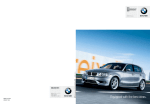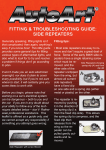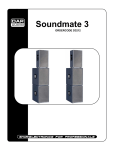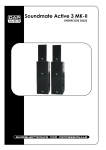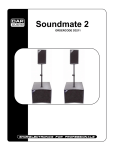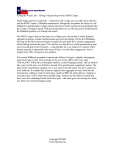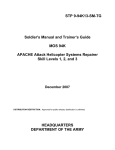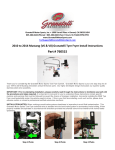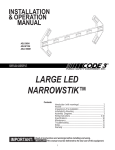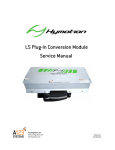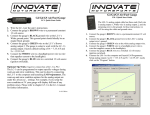Download FITTING & TROUBLESHOOTING GUIDE: HEADLIGHTS
Transcript
FITTING & TROUBLESHOOTING GUIDE: HEADLIGHTS Generally speaking, fitting lights isn’t that complicated; then again, anything’s easy if you know how! This little guide provides some general tips for fitting various types of aftermarket lights, and also what to look for to try and resolve a problem if things don’t go according to plan. It won’t make you an auto electrician overnight, nor does it claim to cover every possibility, but if you’re not sure where to start, it will certainly give you some ideas to work with. Before you begin, please note that working on a car’s electrical system can be dangerous – both to you and the car. If you are in any doubt about your ability to follow any of the techniques detailed below – don’t! Rather seek professional assistance. This leaflet is offered as a guide only, and we cannot accept any responsibility if something you attempt goes wrong. Fitting tips: • It’s useful to have an assistant hold the headlight in place, both when removing and installing, as it could otherwise fall and be damaged. • Before tightening anything, make sure that any sealing gaskets or rubber trim strips are correctly positioned and securely held in place. • Make sure that no wires are trapped between the light and the bodywork. • When doing up the mounting nuts or screws, always tighten them all to finger tightness before doing them up with a spanner. Sometimes it may be necessary to tighten one and loosen another to get the panel gaps even. • Don’t overtighten nuts or screws either, as this can lead to broken or stripped mountings – which are not covered under warranty either for obvious reasons. • Most aftermarket headlights will not fit to exactly the same standard as the original equipment items in terms of the panel gaps between the light and the car body. If the difference between the original and aftermarket lights is not more than 3 mm, this would be considered to be within specification. Problem Solving: 1. Leaking: • If moisture is getting into the headlight, the first thing is to determine if there is actually a leak or if it’s just condensation (see general information at the end of this guide for an explanation of condensation). • Check that the dustcovers on the back of the light unit are fitted properly. Check that dustcovers on the back of headlights are fitted securely, and that wiring is connected properly • Check that the bonding between the lens & housing is secure all the way round, and that none of the spring clips are missing. • Many headlights have vents on the back to allow air to circulate. These usually have a push-fit curved rubber tube on them, which should be pointing downward to prevent water running in. Check to see if any of them are missing or out of position. 2. Bulbs not lighting up: • Most headlights are supplied with pre-fitted wiring harnesses, but if a particular bulb doesn’t light up, it’s worth removing the dust cover and checking that the terminals are connected properly inside. • Check that the bulb hasn’t blown. Bulbs are service items with a finite life, and will only be replaced under warranty if the bulb is blown on receipt of the light unit. Bulbs which blow after this are the customer’s responsibility. 3. Angel eye rings don’t light up: • If only one doesn’t light up, it could possible be a faulty LED bulb, and these are available as spares. Note, however, that like incandescent bulbs, these are consumable items with a finite life, and they will only be replaced under warranty if they are faulty when the item is first received by the customer. The bulb might also have come loose from its socket and be floating around inside the headlight, so remove the grommet underneath the headlight and check. Remove rubber grommets underneath the headlight unit to gain access to the LED bulbs for the angel eye rings • If none of the four angel eye rings light up, the problem is almost certainly with the wiring, as the chances of all four bulbs being duds is extremely unlikely. It’s also possible that all four bulbs have been inserted the wrong way round. • Many headlights require the angel eye wiring (and that for the LED sidelights, if present) to be connected before fitment, either directly to the sidelight circuit or via a separate switch if desired. Check that this has been done. • If any connections have been made using “Scotchlock” type inline splicers, butt connectors or any of the crimp connectors with coloured plastic insulators, check them carefully for continuity, as these connectors are notoriously unreliable. The best way to join wiring is by soldering and insulating with heatshrink tubing, or by using proper crimp connectors with insulating sleeves. • If the wiring has been connected properly and the rings still don’t work, it’s likely to have been connected incorrectly, either to the wrong wires or the wrong way round (unlike incandescent bulbs, LEDs are polarity conscious – if you connect them the wrong way round, they don’t work. This usually won’t damage them, however, unless their voltage rating is exceeded). Resistor box for angel eye LED bulbs The two different types of LED bulb for angel eye rings - the rubber grommets have been removed to show the resistor (arrowed) fitted to the one type. • There are two different types of replacement LED bulbs for angel eye rings and LED sidelights – one has resistors built in, the other doesn’t. It’s important to establish what type the headlight uses, as they aren’t interchangeable. Resistor-type bulbs can be identified by checking to see if any resistor boxes are fitted to the angel eye or sidelight wiring, or in the case of the angel eye bulbs, by looking at the LED bulb itself - slide back the rubber grommet to reveal the circuit board underneath and see if a resistor is fitted or not. • If a resistor type bulb is fitted where a non-resistor type is needed, it will light up but emit a dull yellow- rather than a white light; if a non-resistor type is fitted where a resistor type is needed, it will blow instantly - and that won’t be covered by warranty either, for obvious reasons! • Note that certain headlights have a number of small capless bulbs fitted at intervals around the ring. These can be replaced, but usually the headlight must be disassembled to do so. Instructions on how to do this are normally included with the lights. • Some headlights have a non-replaceable LED ring, and if this fails during the warranty period, the entire unit will need to be replaced. Check with the supplier first. 4. Car fails MOT because lights are not adjusted correctly: • Although most headlights will be reasonably close to the required setting out of the box, it is imperative that the beams are checked for correct adjustment once they are fitted. This doesn’t necessarily require expensive equipment, but it does require that the person adjusting them knows what they are doing. That means that they need to know how to measure whether the lights are adjusted correctly, and which adjusters to turn to achieve the correct result. • Problems invariably arise when people without the necessary knowledge start turning the adjusters randomly and end up getting themselves (and the lights) in an awful mess. If the adjusters are turned too far, the light units can kink and jam in the housing, or the adjuster can unscrew itself, leaving the headlight impossible to set correctly. Clearly this kind of problem would not be covered by warranty. • As a general rule, there will be four adjusters on each side, two each for dipped & main beam units -although some of the newer cars have only two adjusters each side, so that once the dipped beam is set up, the main beam is automatically at the correct setting. Adjusting lever behind dipped beam unit for setting lights for leftor right-hand drive use. • Some units will have three adjusters, but the one in the middle will be the pivot point for the light unit, and should under normal circumstances not be moved at all (if it has been turned, it must be returned to the centre position before any further adjustment can be made). Typical location of headlight adjusters • When adjusting a headlight, it is very rarely necessary to turn the adjusters very far, as even one turn will make a big difference to where the beam is pointing. If you have to turn the adjusters much more than two full turns, it’s likely there’s a problem somewhere else. If the adjusting screws are mashed and beaten up, the chances are good that someone before you has had a twiddlefest with them, and that’s most likely the cause of the problem. Can’t blame the lights for that, though. 5. Headlights are for a left-hand drive car: • Are they really though? Check first, as the problem can be caused by twiddleitis, as detailed above. Of course it’s possible for a headlight to be incorrectly labelled, but in our experience most problems of this nature are caused by maladjustment. • There is a common belief that headlights in the UK must be adjusted to point to the left. This is NOT the case – they should point straight ahead at an angle of between 1.2 & 1.5 percent below the horizontal, depending on the car concerned. The cut-off pattern to the left required under UK law is a factor of the lens or reflector design, and nothing to do with the adjustment. Holding the headlight level and shining it onto a wall with dipped beam selected will produce a distinctive pattern that can be used to identify if the headlight is for left- or right-hand drive, as can be seen in the graphic alongside. • Some headlights can be set for use on either left- or right-hand drive cars, either by moving a lever (as in the image) or by loosening three screws, turning the dipped beam unit and retightening them. Instructions will usually be on the lights in the form of a sticker explaining what to do. Graphic showing the difference between left- and right-hand drive dipped beam headlight patterns. RHD LHD 6. Lenses melting: • This is almost always caused by one of two things – either the fitment of high output bulbs or HID kits, or a bulb having been fitted incorrectly. None of these will be covered under warranty. • Projector headlights use a shaped glass lens to project the beam, instead of relying on patterned headlight lenses as was the case in the good old days. • Anyone who’s ever burned something using a magnifying glass and the sun’s rays will be familiar with the concept. Fit a bulb incorrectly, so that it’s sort-of-inthe-housing-but-not-really-secure, only held in place by the retaining clip, and you’re likely to end up with a melted lens very quickly. Even though the change in distance between the bulb and projector is only a few millimeters, it will be enough to focus the light energy on the outer lens instead of allowing it to pass through, with predictable results. 7. Warning lights show on dashboard after lights have been fitted: • This can sometimes be solved by having the vehicle’s onboard electronic control unit reprogrammed by a dealer; in other cases this may not be possible, and the lights will have to be returned to the supplier for inspection. Incorrectly fitted bulbs or the use of high output bulbs or HID kits can cause headlight lenses to melt. • Some headlights, particularly those for older models, are not compatible with electric height adjustment, and the facility will no longer work once they are fitted - although the headlights themselves will work fine. If electric adjustment is important to you, it’s best to check with the supplier of the headlights before purchasing. • Electric headlight height adjustment is NOT an MOT requirement. Transferring an electric headlight adjustment motor: • Most headlights with electric height adjustment have a small electric motor fitted onto the back of the headlight unit (depending on the headlight design, the motor will sometimes have a manual adjuster on it for inital setting up of the headlights when they are first installed). Correctly installed headlight bulb (top); incorrectly installed bulb in bottom photo will very soon cause the headlight’s outer lens to start melting. 8. A Note About Electric Height Adjustment: • The motor has a rod with a ball on the end, which locates into a socket on the mounting frame of the headlight units inside the headlight housing. The motor is removed from the original light housing by turning it until the locating lugs are loose (usually this is about a quarter of a turn, it may be clockwise or anticlockwise but the direction should be obvious), and then pulling it gently but firmly backwards so that the ball releases from the socket. • There may be a locking tang holding the motor in place, which must first be lifted up with a screwdriver to allow the motor to be turned and removed. • To fit the motor to the new headlights, the pivot that is fitted in place of the motor on the back of the new headlight unit must first be removed. • Many cars these days will have an electric height adjustment facility for the headlights, usually in the form of a thumbwheel on the dashboard near the headlight switch. This facility is commonly misunderstood, so let’s shed some light on what it is and isn’t. Electric height adjustment allows the headlight beam to be adjusted over a narrow vertical range (i.e. up & down), and it’s purpose is to allow the driver to compensate for situations where the rear suspension is compressed, causing the headlights to shine up into the air (for instance when towing a boat or caravan, or when the car is fully loaded and the boot is full). It cannot substitute for manual adjustment, nor can it adjust the headlights in the horizontal plane (left to right). It is only for load compensation, nothing more. • As a result, even if a car has electric height adjustment, the beam adjustment still has to be set in the normal manner when new headlights are fitted. • Some aftermarket headlights are compatible with electric height adjustment, either because they have an adjusting motor already built in, or (more commonly) by making provision for the motor to be transferred across from the old lights - see the guide which follows. Adjustment motor showing locking tang (arrowed). • On some headlights - such as the one shown in the photo - the pivot is clearly visible on the back of the light unit; on others it may be necessary to remove a cover that may clip in place or be held in with screws, and the pivot will be found under the cover. If this is the case, wiring and a socket for connection to the motor will also be found inside the cover. • Once the pivot has been removed, the motor can be fitted in its place, and the wiring connected to it. It may sometimes be necessary to hold the light unit frame in position by hand or with a screwdriver so that the nylon socket is close enough for the ball to be slipped in place. • The pivot is removed in a similar way to the motor, by turning it a quarter of a turn (usually anticlockwise, but not always, so check carefully - it should be fairly obvious) to loosen it before removing it completely. Screw pivot adjuster all the way in before removing Adjustment motor removed from old headlight unit, locating lugs are clearly visible. • It’s best to screw the adjuster in the centre of the pivot all the way in first, as this makes it easier to remove the pivot. Also note that on many headlights the ball slides into the socket from the side rather than pushing straight in, so be careful when removing and refitting, as it is easy to damage the nylon socket, and this will render the headlight useless as spares are not available. Removing the pivot from the new headlight unit Pivot after removal from new headlight unit. Pivot on rear of new headlight unit. GENERAL INFORMATION • Know your left from your right: References to left-hand & right-hand are as viewed by someone sitting in the driver’s seat. Nylon socket showing slot for ball on motor shaft. • What exactly IS condensation? Condensation is caused by water vapour in the air. The moisture on the windows inside your house in winter is conndensation – and when that happens, you don’t start looking for leaks in your windows do you? (You’ll be a long time if you do). In exactly the same way, condensation inside a light unit is hardly ever caused by a leak. • The basic scientific explanation is this: There is always some moisture in the air, and warm air can hold more moisture than cold air. When the air inside the light unit – which is warmed by the heat from the bulbs – touches the inside of the lens (which is at a lower temperature because it is in contact with the colder air outside), the layer of air against the inside of the lens cools down as well, and as a result it can no longer retain the moisture it is holding, which is deposited on the inside of the lens in the form of condensation. • The condensation will only disappear once the air inside the light unit warms up enough to absorb the moisture again, and in winter this can take time. Holding the frame in position so that the nylon socket is accessible. Motor fitted to new headlight unit in place of pivot. Manual adjuster is indicated by arrow. • Test that the height adjustment function works before fitting the headlights to the car. • Condensation is NOT indicative of a fault with a light unit, and as such it isn’t accepted as a reason for a warranty return. • Condensation occurs in original equipment lights as well, but aftermarket lights often have clear lenses without any patterns, so the condensation is more obvious. On a patterned original equipment lens it might not be visible at all unless one looks closely. While the above information is offered in good faith and is believed to be correct, neither AutoArt nor any of its dealers can accept any responsibility for any consequences, howsoever caused, resulting from the application of any of the information detailed in this leaflet. Copyright 2009 AutoArt Styling Limited. Unauthorised duplication/distribution prohibited.






